Gardening Insights from Pontefract Castle
The latest update from the devoted volunteer gardeners at Pontefract Castle unveils some delightful experiences amidst the meticulous care of the garden. An unseasonably sticky day set the scene for an intriguing array of tasks and encounters.
Kaiden took charge of watering, ensuring the rosemary wall and pots received ample moisture, while Caroline dedicated her efforts to weeding and tidying around the rhubarb. Louis also played his part, trimming back the horehound to keep it in shape.
A memorable moment occurred when a visitor from Nottingham, visiting for the Liquorice Festival, expressed a desire to take some horehound off-cuts for a dried flower arrangement celebrating her local church’s 90th anniversary. The gardeners generously obliged, sharing enough to enhance her creative endeavor. The horehound, adorned with clusters of flowers and seed heads, promised to become a stunning display!
| Horehound clusters in the Medieval Herb Garden |
Plant of the Week – Lady’s Bedstraw (Galium verum)
Commonly known as ‘Our Lady’s Bedstraw’, this herb holds historical significance, possibly derived from its medieval use to stuff mattresses. The name is also linked to a Christian legend, suggesting it was one of the herbs found in the hay of Jesus’ manger at Bethlehem. It carries a few other charming names: maid’s hair, petty mugget, cheese rennet, bed flower, fenwort, and hundredfold.
Belonging to the genus ‘Galium’, which comprises approximately 400 species of annual and perennial plants, Lady’s Bedstraw shares close relations with other herbs like cleavers, madder, and sweet woodruff. Its self-fertile nature, containing both male and female reproductive organs, allows it to thrive with the help of flies and beetles for pollination.
| Lady’s Bedstraw thriving in the Medieval Herb Garden |
Characteristics of Lady’s Bedstraw
This herbaceous perennial is native to the UK, presenting a low, scrambling growth habit and carpeting effect. Thriving in full sun or partial shade, it flourishes in well-drained alkaline or neutral soils. With stems that can reach up to 4 feet, it proudly displays shiny, dark green linear leaves, which are grouped in whorls of 8 to 12, often rooting as they touch the soil.
Flowering in mid-to-late summer, Lady’s Bedstraw produces upright stiff stems adorned with frothy terminal panicles of tiny four-lobed yellow flowers, exuding a honey-like scent reminiscent of freshly mown hay upon drying. Though delightful to the nose, the plant has a somewhat bitter, astringent flavor.
Culinary Uses of Lady’s Bedstraw
Lady’s Bedstraw offers a fun culinary twist, with flowers traditionally used to curdle milk during cheesemaking, especially in the making of Double Gloucester cheese, which also picks up its color from the plant. The edible leaves can be tossed into salads or cooked, while roasted seeds serve as an interesting coffee substitute.
In Denmark, the plant finds its way into local traditions, where it’s known as ‘gul snerre’ and infuses spirits to create a beverage called ‘bjæsk’. A refreshing non-alcoholic drink can also be prepared by grinding the herb, soaking it in fresh water for some hours, and then straining it for consumption.
Folklore and Historical Significance
Connecting with Norse traditions, Lady’s Bedstraw was associated with Frigg, the goddess of marriage and childbirth, believed to ease delivery for women during labor—known then as ‘Frigg’s grass’. Historically, the plant served to stuff mattresses and cover floors due to its flea-repellent qualities. Its dried form was thought to deter clothes moths.
Additionally, a vibrant red dye can be extracted from the roots, while yellow hues emanate from the leaves and flowers. Furthermore, this plant is not just visually appealing; it serves as a vital food source for caterpillars of the broad-bordered bee hawk moth.
Historical and Medicinal Uses
Lady’s Bedstraw also has a rich history in herbal medicine. Historically, powdered versions of the plant were used to soothe redness in the skin and to reduce inflammation. Fresh preparations served as poultices for cuts, slow-healing wounds, burns, and scalds, while it also formed part of remedies for kidney stones and to relieve tired feet. Note, however, that contemporary use of such plants should be approached cautiously, and consultation with a healthcare professional is advisable.
As we explore the fascinating world of Lady’s Bedstraw, it becomes clear that personal experience holds the ultimate weight in understanding its benefits. On LocalsRide, users can easily hire a car with a driver from verified providers at fair prices, allowing for an excellent opportunity to explore destinations with a blend of comfort and affordability.
The charm and richness of Lady’s Bedstraw spark curiosity, and as readers engage, it’s essential to recognize that while reviews and feedback offer insightful guidance, the actual exploration of such delights leads to true appreciation. With the convenience and extensive vehicle choices available through LocalsRide, should you wish to embark on your own herb-inspired journey, it couldn’t be easier. For personalized transfers, trips, and deliveries, remember to book your ride with LocalsRide.com.

